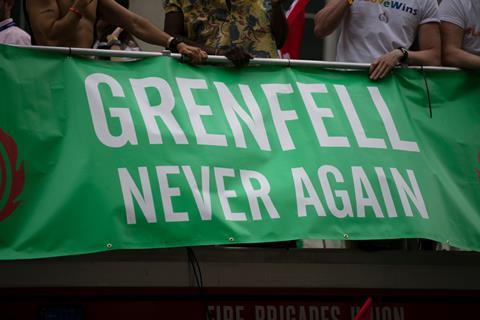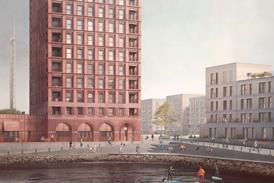Inquiry’s final report reserves some of its strongest criticism for architect behind tower’s refurbishment
The practice that designed the disastrous refurbishment of Grenfell Tower bears a “significant degree” of responsibility for the fire which killed 72 people in 2017, according to the final report of the inquiry looking into the causes of the blaze.
Studio E, which went into liquidation in 2020, was strongly criticised in the report for failing to recognise the dangers of installing the combustible ACM cladding used on the tower’s refurbishment. The cladding panels, supplied by Arconic, have been found to be the primary cause of the fire.
The 1,600-page report of the second phase of the inquiry was published this morning and looks into the causes of the fire at the west London building.
It identified an array of culpable actors from government officials to product manufacturers, but reserved particularly strong criticism for Studio E, which had never worked on a high rise project before being appointed to design the overhaul of Grenfell Tower.
The report said the firm’s failure to recognise that ACM was dangerous and to warn the client, Kensington & Chelsea Tenant Management Organisation (the TMO), against its use represented a failure to act as a “reasonably competent architect”.
“As architect Studio E was responsible for the design of the external wall and for the choice of the materials used in its construction.”
“While the TMO wanted to reduce cost by using ACM rainscreen panels the inquiry found it was Studio E’s responsibility to determine whether the use of such material would enable to building to compley with regulations.
“It failure to recognise that ACM was dangerous and to warn the TMO against its use represented a failure to act in accordance with the standard of a reasonably competent architect.
“It also failed to recognise that Celotex insulation was combustible and not suitable for use on a building over 18 metres in height in accordance with the statutory guidance. Studio E therefore bears a very significant degree of responsibility for the disaster.”
The report also strongly criticised several other firms working on the project team for the refurbishment, including main contractor Rydon, facade engineer Harley and fire consultant Exova.

The inquiry found that the choice of combustible materials for the cladding “resulted from a series of errors caused by the incompetence of the organisations and individuals involved in the refurbishment”.
The report also determined that an “absence of formality” in contractual relations had resulted in firms involved in the refurbishment not understanding their own responsibilities, and hit out at a “widespread” and “unprofessional” culture in the construction industry of “getting on with the job without waiting for terms to be formally agreed”.
It said Rydon, Harley and Studio E all took “a casual approach to contractual relations” and “did not properly understand the nature and scope of the obligations they had undertaken, or, if they did, paid scant attention to them.”
“They failed to identify their own responsibilities for important aspects of the design and in each case assumed that someone else was responsible for matters affecting fire safety,” it added.
“Everyone involved in the choice of the materials to be used in the external wall thought that responsibility for their suitability and safety lay with someone else”.
The inquiry found that none of those involved in the design of the external wall or the choice of materials had acted in accordance with the standards of a reasonably competent person in their position.
It said that Rydon and Harley relied on previous experience rather than on technical analysis or expertise, while Studio E was found to have “demonstrated a cavalier attitude” to fire safety regulations.
The inquiry identified “many other respects” in which Studio E failed to meet the standards of a reasonably competent architect, among the most significant being its failure to ensure that consultant Exova completed the fire safety strategy for the refurbished building.
For its own part, Exova was found to have “considerable responsibility” for Grenfell ending up in such a dangerous condition, citing its failure to produce a final version of a fire safety strategy for the refurbished building and that none of those responsible for drafting the fire safety strategy had visited the tower.
“Exova’s attitude was wholly inconsistent with the careful approach to matters affecting the safety of life to be expected of a reasonably competent fire engineer,” it said.
The inquiry said Rydon also bears “considerable responsibility for the fire”, having displayed “a casual” attitude to fire safety throughout the project.
“Rydon itself did not understand where responsibility for individual decisions lay and as a result it failed to co-ordinate the design work properly,” the report found.
The firm also had an “inexperienced” team on the job, who did not have sufficient knowledge of Building Regulations or Approved Document B and relied entirely on its cladding subcontractor, Harley, to draw attention to any errors in the design, but did not specifically ask the business to assess Studio E’s work.
Harley also “failed in many respects to meet the standards to be expected of a reasonably competent cladding contractor”, according to the report and said it had a “significant degree of responsibility” for the fire.
According to the inquiry, the firm did not concern itself sufficiently with fire safety “at any stage” and appeared to have thought there was no need for it to do so, as others in the project, and ultimately building control, would ensure the building was safe.
The Royal Borough of Kensington and Chelsea’s building control department “failed to perform its statutory function of ensuring that the design of the refurbishment complied with the Building Regulations” and “bears considerable responsibility for the dangerous condition of the building immediately on completion of the work”
Meanwhile, the TMO, as client, had “failed to take sufficient care in its choice of architect and paid insufficient attention to matters affecting fire safety, including the work of the fire engineer” and that it “must also bear a share of the blame”.
While the inquiry was not tasked with examining the performance of the industry at large, it did note that the way in which the refurbishment job on Grenfell Tower was handled raised “serious questions for the whole industry” and said there was a “great deal to be done” to raise competence levels.
“A number of common themes can be seen running through the story which, due to their nature, we think are likely to be repeated widely across the construction industry,” it said, criticising the fact that lack of formality in contractual relations on the project.
Harley, for example, never signed a formal contract, while a number of key actors in the design and installation were also employed by “word-of-mouth” agreements.
“Such a casual approach to contractual relations is a recipe for disaster if events take an unexpected turn,” it said.
“What appears to be a widespread culture of getting on with the job without waiting for terms to be formally agreed is unprofessional and likely to result in a failure by those carrying out the work on site to understand the scope of their responsibilities”
It was this lack of contractual clarity which in part resulted in the “unedifying ‘merry-go-round of buck-passing’ in which the construction professionals all pointed the finger at each other”, which was seen during the inquiry hearings.
The inquiry also drew attention to the predominant model of design-and-build contracting in the construction industry, under which Rydon saw its job as “little more than the conductor of a large and varied orchestra”
The inquiry acknowledged that, given the complexity of modern construction, no main contractor can be expected to employ people with the full range of skills required for every project it takes on, it insisted that firms in this role “must ensure that within its organisation it has access to sufficient knowledge and expertise to be able to monitor the work of its sub-contractors and consultants effectively”.
It also criticised the approach of the Grenfell refurbishment project team to building control, with most on the job regarding it as effectively another consultant on the job.
This, it said, was “compounded by the adoption of a similar attitude” on the part of the local authority’s building control department, which “saw its function as being to ‘work with’ employers and contractors” rather than to “act as the custodian and enforcer of the Building Regulations in the public interest”.
















3 Readers' comments